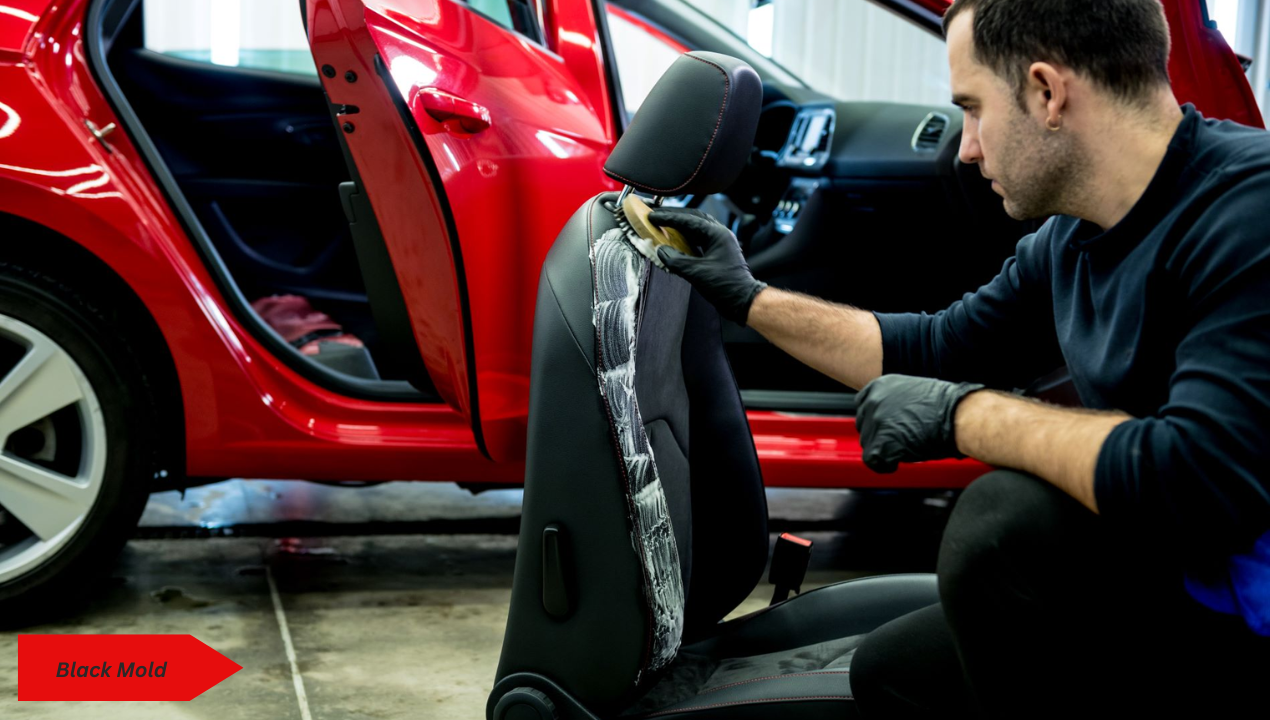Fortunately, with the right tools and techniques, you can effectively remove mold and keep your car interior clean and fresh.
Here’s a comprehensive guide on how to remove mold from car seat covers.
Causes of Mold in Car Seat Covers
Mold can grow on car seat covers for several reasons:
- Moisture Exposure: Spills, wet clothes, or high humidity levels.
- Poor Ventilation: Lack of air circulation inside the car.
- Damp Weather Conditions: Living in or parking in humid climates.
Health Risks of Mold
Exposure to mold can lead to:
- Respiratory issues and allergies.
- Skin irritation.
- Unpleasant odors making the car uncomfortable.
Tools and Materials Needed
Before you start the mold removal process, gather these items:
- Vacuum cleaner with a HEPA filter
- Soft-bristled brush
- Microfiber cloths
- Bucket
- White vinegar or specialized mold remover
- Baking soda
- Tea tree oil (optional)
- Protective gear: gloves, mask, and safety glasses
Step-by-Step Mold Removal Process
Initial Inspection and Preparation
- Inspect the Seat Covers: Check for the extent of mold growth.
- Ventilate the Car: Open all car doors and windows to allow airflow.
- Protect Yourself: Wear gloves, a mask, and safety glasses to avoid contact with mold spores.
Removing Loose Mold
- Vacuum the Seat Covers: Use a vacuum cleaner with a HEPA filter to remove loose mold. This step prevents mold spores from spreading.
Applying Cleaning Solution
- Prepare the Solution: Mix equal parts of water and white vinegar in a spray bottle. Alternatively, use a commercial mold remover.
- Test a Small Area: Spray a small, hidden area of the seat cover to ensure it doesn’t cause discoloration.
Cleaning the Mold
- Spray the Solution: Generously spray the moldy areas with the cleaning solution.
- Scrub Gently: Use a soft-bristled brush to scrub the mold from the fabric.
- Wipe Down: After scrubbing, wipe the area with a damp microfiber cloth.
Using Baking Soda
- Apply Baking Soda: Sprinkle baking soda on the moldy areas and let it sit for 15-20 minutes.
- Brush and Vacuum: Use a soft-bristled brush to scrub the baking soda into the fabric, then vacuum the area to remove the residue.
Using Tea Tree Oil (Optional)
- Prepare Tea Tree Oil Solution: Mix a teaspoon of tea tree oil with a cup of water.
- Spray and Leave to Dry: Spray the solution onto the moldy areas and leave it to air dry.
Drying the Seat Covers
- Dry Thoroughly: Use a wet/dry vacuum to remove excess moisture. Leave the car doors open to allow the seat covers to air dry completely.
- Use Fans or Dehumidifiers: These can help speed up the drying process and ensure no moisture is left.
Aftercare Tips
Keep the Seat Covers Dry
After cleaning, it’s essential to keep your car seat covers dry to prevent mold from returning. Use moisture absorbers and ensure good ventilation inside your car.
Regular Maintenance Checks
Regularly inspect your car seat covers for any signs of mold. Early detection can prevent a small problem from becoming a significant issue.
Conclusion
Removing mold from car seat covers is a task that requires patience and the right approach. By following the steps outlined above, you can effectively eliminate mold and keep your car interior clean and healthy. Remember, prevention is key, so keep your car dry and maintain a regular cleaning routine to avoid future mold issues.
FAQs
Can I use bleach to remove mold from car seat covers?
Bleach is not recommended for fabric as it can damage and discolor the material. Stick to vinegar, baking soda, or commercial mold removers designed for fabric.
How often should I clean my car seat covers to prevent mold?
Regular cleaning every few weeks can help prevent mold. Increase the frequency if you live in a humid area or frequently spill liquids in your car.
Are there any eco-friendly mold removal options?
Yes, natural solutions like vinegar, baking soda, and tea tree oil are effective and eco-friendly options for removing mold.
Can mold return after removal?
Yes, mold can return if the underlying moisture problem is not addressed. Ensure your car remains dry and well-ventilated to prevent recurrence.
Is mold removal covered by car insurance?
Typically, mold removal is not covered by car insurance unless it results from a covered peril like a flood. Check your insurance policy for specific details.
